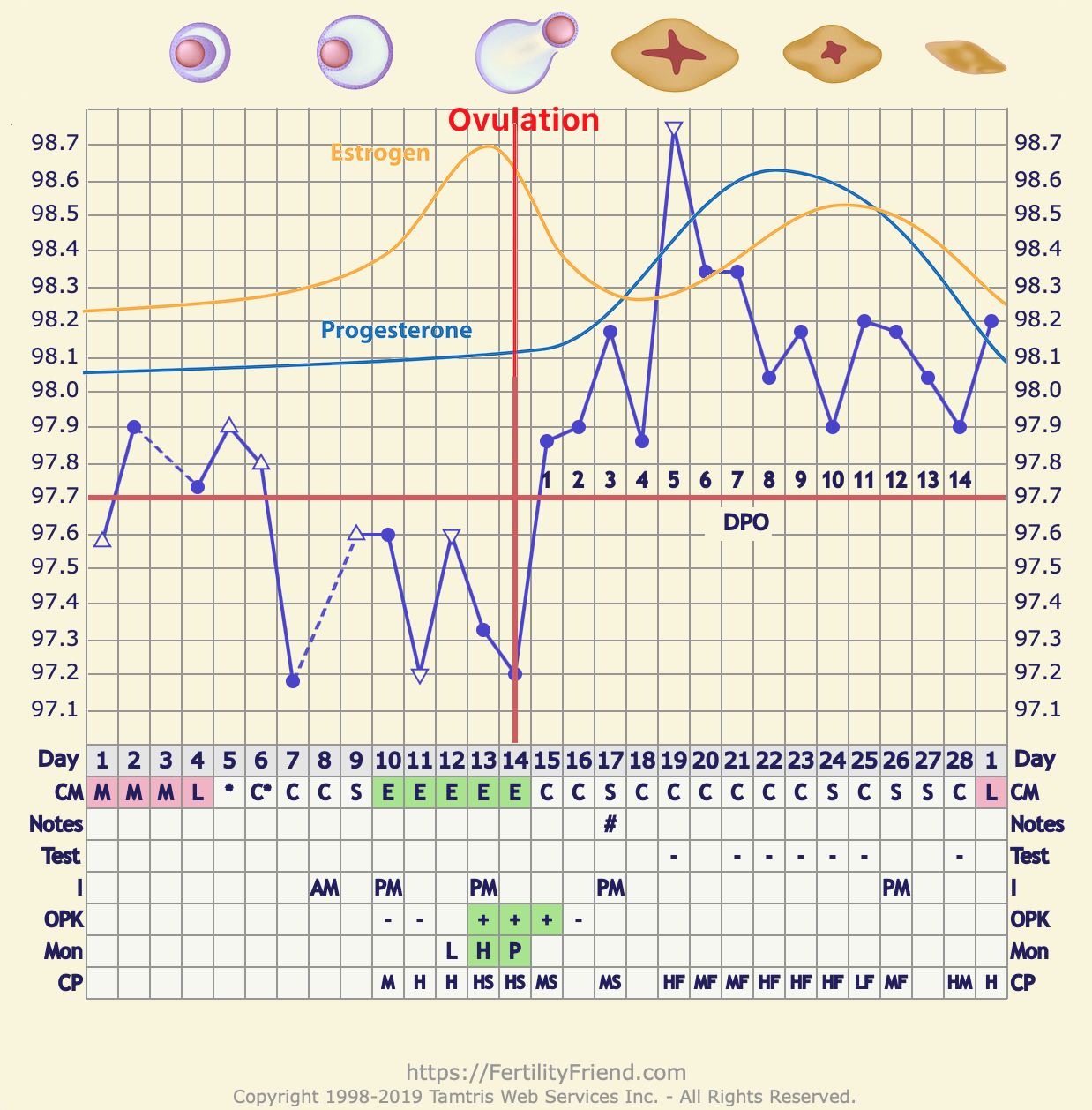Lesson Objectives:
Understand the role of your hormones in the menstrual cycle.
Understand how hormonal processes relate to your fertility signals.
Major Points in this Lesson:
The following fertility signs tell about the presence of estrogen: cervical fluid, cervix position, saliva microscopes, some fertility monitors.
Basal Body Temperature (BBT) tells about the presence of progesterone.
Ovulation Prediction Kits (OPKs) and some fertility monitors tell about the presence of Luteinizing Hormone (LH).
Estrogen is high before ovulation.
Progesterone is high after ovulation and during pregnancy.
Luteinizing Hormone (LH) peaks just before ovulation and is responsible for causing the rupture of the ovarian sac to release the ovum for ovulation.
More...
Each of the fertility signals that you observe when you chart your fertility signs corresponds to a hormonal process and the presence of hormones in your bloodstream. Estrogen and progesterone are the significant hormones that offer the signals you observe when charting your fertility signs.
Estrogen dominates your menstrual cycle during your pre-ovulation (follicular) phase. Progesterone takes over after ovulation, during your luteal phase. Progesterone is also the dominant hormone during pregnancy should conception occur.
Your cervical fluid and
cervical position provide clues about estrogen, as do saliva
microscopes and fertility monitors.
Your Basal Body
Temperature (BBT) tells you about the presence of progesterone.
Ovulation Prediction Kits and some types of fertility
monitors tell you about the presence of LH (Luteinizing Hormone), the
last hormone to peak before ovulation.
Estrogen and Your Fertility Signs
Estrogen refers to a group of hormones that stimulate growth and strengthen tissues. It is needed to build up the lining of the uterus so that it may nourish and sustain a fertilized egg. When we are talking about fertility, the kind of estrogen we are referring to is called estradiol. This estrogen is produced by the developing ovarian follicles and later, in increasing amounts, by the dominant follicle before it is released at ovulation. Estrogen has many roles in reproduction:
Estrogen signals the release of LH (Luteinizing Hormone) which is needed to trigger ovulation.
Estrogen is needed to build up the endometrium (the lining of the uterus) so that a fertilized egg can find nourishment and implant.
Estrogen produces cervical fluid which is necessary for the sperm to travel to the fallopian tube where the egg may be fertilized.
Estrogen causes the cervix to soften and open so that the sperm may enter and reach the fallopian tube for fertilization.
Some signs of
increased estrogen that you can easily observe on your own are the
presence, quantity and consistency of cervical fluid and the position
and texture of your cervix. These signs offer some of the best
indicators of your fertility status.
While estrogen dominates the pre-ovulatory, follicular phase of your cycle, progesterone dominates the post-ovulatory, luteal phase of your cycle. Before ovulation, progesterone is present only in very small amounts. After ovulation, progesterone is produced by the corpus luteum (the remains of the ovarian follicle after ovulation), and is present in dramatically higher amounts. Progesterone plays the following roles:
Progesterone makes the lining of your uterus soft and spongy so that a fertilized egg can latch onto it and implant.
Progesterone is needed to support and sustain pregnancy.
Progesterone causes your Basal Body Temperature (BBT) to rise after ovulation so that it is measurable with a BBT thermometer.
Progesterone causes your BBT to stay elevated throughout pregnancy.
The chart below shows how estrogen relates to your cervical fluid sign and progesterone relates to BBT.

Luteinizing Hormone (LH) is the last hormone to peak before ovulation and is the hormone responsible for triggering the rupture of the ovarian sac that releases the egg at ovulation. This hormone can be measured by ovulation prediction kits (OPKs) and fertility monitors that use chemicals to identify its presence in your urine.
The presence of increased amounts of LH in your urine, as detected by OPKs, usually means that you will ovulate within 12-24 hours but this can vary slightly depending on your own hormonal profile. LH is not released all at once, but rather it rises and falls for about 24-48 hours. The LH rise usually begins in the early morning while you are sleeping and it takes 4-6 hours for it to appear in your urine after that. For this reason, first morning urine may not give the best result. Testing mid-day is usually recommended. It is important to follow the instructions of your OPK for maximum results.
Many women like ovulation
prediction kits, even though they are not able to confirm or pinpoint
ovulation precisely, because they can tell you that ovulation is
imminent. It is important, however, not to rely exclusively on
OPKs for timing intercourse and identifying your most fertile time.
This is because you may already be fertile before your OPK
turns positive. You may like to use them to cross-check
your other fertility signs and to offer additional clues about
impending ovulation. They may be especially useful if you have
ambiguous charts. If your cycles are irregular or very long, OPKs may
be very costly because you may need to use several tests to be sure
to catch the LH surge.
Next Lesson: All about Cervical Fluid.
Note: Please check this lesson within the app to access the lesson quiz.
© Tamtris Web Services Inc.
Terms Of Service || Privacy Policy || Contact